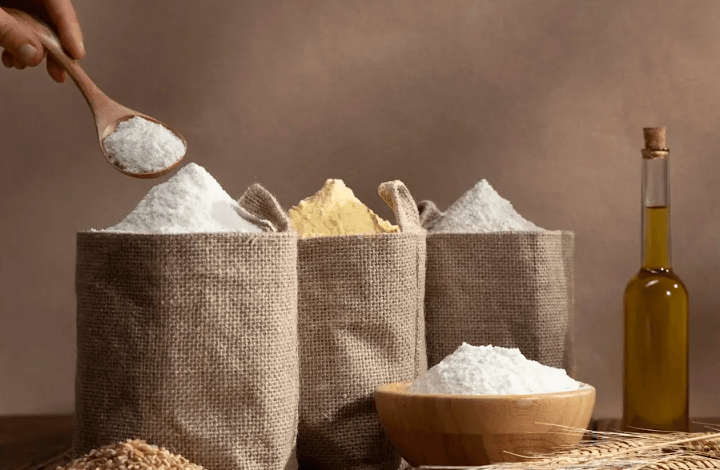Beyond All-Purpose: Exploring 7 Flour Types Every Baker Should Know

You know there’s more to baking than just all-purpose flour, but have you ever stopped to think about what makes cake flour different from bread flour? Understanding the unique characteristics of various flour types is key to being an all-star baker. In this article, you’ll learn about 7 essential flours that every baker should have in their pantry, from the featherlight texture of cake flour to the hearty goodness of whole wheat. I’ll explain the differences in protein content, gluten formation, and flavor so you can make smart substitutions in all your favorite recipes. You’ll also get tips on how to adjust recipes to accommodate different flours, whether you’re avoiding gluten or just want to experiment with nuttier, earthier flavors. With the right flours, you can make everything from ethereal pastries to crusty artisan loaves. Time to move beyond all-purpose and become a flour pro!
The 8 Essential Flour Types for Baking Success
- All-Purpose Flour
Your go-to flour for most recipes, all-purpose flour has a medium protein content that leads to decent gluten development and structure. Use it for cookies, quick breads, pancakes and of course, all-purpose doughs.
- Bread Flour
With the highest protein content, bread flour yields chewy artisan loaves and baguettes. The abundant gluten helps trapped air bubbles, creating a light and airy crumb. Bread flour may be substituted for all-purpose flour, but it will yield heavier results.
- Cake Flour
The fine, soft texture of cake flour produces deliciously light and tender cakes. Low in protein with minimal gluten, cake flour won’t yield the same chewy texture as all-purpose flour. For the best results, use cake flour when a recipe specifies it.
4. Self Rising Flour
Pre-mixed with baking powder and salt, self rising flour simplifies recipes like biscuits and pancakes, providing consistent results with minimal ingredients.
5. Pastry Flour
Also low in protein, pastry flour creates flaky crusts and pastries. Similar to cake flour but with a slightly higher protein content, pastry flour can be substituted for cake flour but may produce slightly denser results.
6. Whole Wheat Flour
Nutrient-dense whole wheat flour adds hearty flavor and texture. Milled from the entire wheat berry, whole wheat flour is high in fiber and nutrition. Substitute up to 1/2 the all-purpose flour in recipes for added nutrition and texture.
7. Semolina Flour
Coarsely ground durum wheat, semolina flour has a pale yellow color and sandy texture. High in protein, semolina flour is commonly used to make pasta, couscous and some rustic breads.
8. Rice Flour
For gluten-free baking, rice flour creates light and airy results. Made from ground rice, it has a neutral flavor and fine, powdery texture. Use rice flour as a 1:1 substitute for all-purpose flour in most recipes.
Flour Protein Levels and Gluten Development Demystified
Bakers, listen up. The protein level in your flour directly affects how much gluten develops, which impacts the strength and structure of your dough. So choosing the right flour for your recipe is key.
- All-Purpose Flour: The Go-To for Most Baking: All-purpose flour typically has a mid-range protein level, around 10-12%, that provides enough gluten for most recipes. If a recipe doesn’t specify a flour type, all-purpose is a safe bet. You can substitute it for bread flour or whole wheat flour, you’ll just need to adjust the amount of liquid.
- Bread Flour: For Chewy Breads and Pizza: Bread flour has a higher protein level, usually 12-14%, so it develops more gluten, resulting in chewier breads, pizza, and rolls. If substituting for all-purpose flour, use about 1/4 less bread flour and increase the liquid by a tablespoon at a time until the dough comes together.
- Whole Wheat Flour: Nutritious and Hearty: Whole wheat flour contains the bran and germ, giving it a slightly nutty, hearty flavor and a protein level similar to bread flour. Because the bran absorbs more liquid, you’ll need to increase liquids by at least 1/4 cup for every cup of whole wheat flour substituted for all-purpose. You can combine whole wheat and all-purpose flours for more flexibility.
- Cake Flour: Light and Fluffy: Cake flour has a lower protein level, around 7-9%, resulting in less gluten development so you get tender cakes and pastries. When substituting for all-purpose flour, use about 1 1/4 cups cake flour for every 1 cup of all-purpose flour and reduce liquids by a couple tablespoons.
The type of flour you choose can make or break your recipe, so get to know the different protein levels and how they affect gluten development. With the right substitutions, you’ll be whipping up light and fluffy cakes or chewy pizza dough in no time. Happy baking!
Mastering Flour Substitutions and Enhancing Nutrition
Enhance Nutrition with Alternative Flours
Using alternative flours in place of all-purpose flour adds nutritional benefits to your baked goods. For example, almond flour provides protein, vitamin E, and healthy fats. Coconut flour is high in fiber and suitable for grain-free, paleo, and keto diets. Other choices like buckwheat, teff, and oat flour offer antioxidants, prebiotics to support gut health, and other nutrients. Substitute up to 1/3 of the all-purpose flour in a recipe with your chosen alternative flour. You may need to adjust the amount of liquid or leavening.
Adjusting for Protein and Gluten
The protein level in flour determines how much gluten develops when mixed with liquid, which provides structure in yeast breads and chewy cookies. All-purpose flour has a medium protein level, while bread flour has more protein for yeast bread. In contrast, cake and pastry flours have lower protein for tender cakes and pastries. When substituting, use a flour with a similar protein level. For example, replace all-purpose flour 1:1 with whole wheat flour in cookies, or use bread flour and vital wheat gluten to boost structure in whole wheat yeast bread.
Considering Flavor Profiles
Alternative flours also provide distinct flavors. Nut flours like almond and hazelnut have a mild nutty flavor, while buckwheat flour has an earthy, nutty flavor that pairs well with molasses and spices like cinnamon. Coconut flour absorbs a lot of liquid but provides a subtle coconut flavor. Teff flour has a molasses-like, malty flavor and is naturally sweet. Pair these flours with mix-ins and flavors that complement their unique tastes.
With some experimentation, you can enhance nutrition, adjust texture, and create more complex flavors in your baked goods by using a variety of alternative flours. Start by substituting one flour at a time, note how it impacts the recipe, and have fun with the results!
Conclusion
Diving into the world of flour beyond all-purpose opens up a realm of possibilities for every baker, where each type—from the sturdy structure of bread flour to the delicate crumb of cake flour—brings unique characteristics to recipes. Understanding protein levels and gluten development empowers you to make informed substitutions, ensuring your baked goods turn out perfectly every time. Whether you’re crafting chewy artisan loaves, airy pastries, or wholesome whole grain treats, a variety of flours allows you to tailor creations to your taste and dietary needs. Experimenting with alternative flours not only boosts nutrition but also introduces new flavors and textures to your baking. Stock your pantry with these essentials, explore their nuances, and let your baking skills shine with endless possibilities beyond all-purpose flour.








